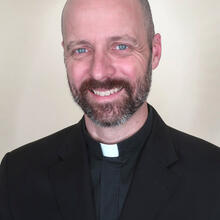What is the Eucharist? Who may and may not receive the Eucharist? And under what circumstances? These important questions for Catholics in the United States have been in the news quite a bit over the past year for reasons both political and pastoral. Regardless of where one stands on these questions, their presence in our conversations offers an opportunity to reflect on the meaning of the Eucharist through a traditional Jesuit devotion: the Sacred Heart of Jesus.
We can speak of the Eucharist in many ways: the new Passover, sacrifice, meal, real presence, Communion. All of these are true descriptions and are attested in Scripture, Catholic tradition and the writings of recent popes. Contemporary debates about the Eucharist among Catholics are often rooted in disagreements about which aspects of the Eucharist ought to be emphasized or de-emphasized in our contemporary culture. The writings of St. Ignatius Loyola and the traditional Catholic devotion to the Sacred Heart highlight a specific aspect of the Eucharist: friendship.
In the visions of St. Margaret Mary Alacoque, Jesus offers his heart to her, telling her, “Behold the heart that has so loved humanity.”
The Sacred Heart
The Sacred Heart devotion is rooted in the visions of St. Margaret Mary Alacoque, who lived in France in the 1600s. In her visions, Jesus offers his heart to her, telling her, “Behold the heart that has so loved humanity.” She recounted this vision in her journal: “Then He seemed to take my very heart from me and place it there in His heart. In return He gave me back part of His flaming heart.” Jesus also invited the faithful to receive Communion more often—especially on the first Friday of each month (a day honoring the Sacred Heart)—and to participate in regular adoration of the Blessed Sacrament.
St. Margaret Mary’s spiritual director was a young Jesuit priest, Claude Colombière, also a saint. Through his appearances to St. Margaret Mary, Jesus called upon Father Colombière to be an apostle of the Sacred Heart by proclaiming the message of Jesus given in these visions. He energetically did so and encouraged his Jesuit brothers to do likewise.
The cultural enemy of this devotion was French Jansenism, sometimes called Catholic Calvinism. Eventually deemed a heresy, Jansenism was a cold, strict interpretation of Catholicism in which the faithful were discouraged from receiving Communion. In the Sacred Heart, Jesus offers a warm and personal rebuttal to this harsh interpretation of the Catholic faith. Against the harshness of Jansenism, Jesus calls the faithful to come to the Eucharist more frequently, not less. This is the ultimate heart-to-heart friendship, which involves a mystical exchange of hearts.
Modern secular culture offers strange parallels to strict Jansenism: the sense that God is distant from our experience and a sense of chilly isolation in daily life. But devotion to the Sacred Heart brings the same message today as in the 1600s: Behold the heart that loves you.
Against the harshness of Jansenism, Jesus calls the faithful to come to the Eucharist more frequently, not less.
Since the late 1600s, the Catholic Church has uniquely entrusted the Jesuits with promoting the devotion to the Sacred Heart. This mission was widely known and appreciated for hundreds of years, though many Jesuits and laypeople are less familiar with it today. The simple message—that Jesus loves us, and he wants us to offer our hearts to him—is not a new revelation. We see countless examples of the love of Jesus in the Gospels. When I speak about the Sacred Heart, especially to young adults, they are intrigued by this devotion. In a complex, divided world and church, the simplicity of this image speaks a clear truth we all need to hear: Jesus loves us.
The image of the heart as a symbol of love is a central motif in many cultures, including our own, particularly in music and literature. How many times every December have we heard the lyrics, “Last Christmas, I gave you my heart”? We also all know phrases like “My achy, breaky heart” and “You gotta have heart.” If you like a post on social media, often you click on a little heart.
In the Bible and in Christian tradition, we see a more robust understanding of the heart. God promised to write his law “upon their hearts” (Jer 31:33); God says, “I will remove the heart of stone from your flesh and give you a heart of flesh” (Ez 36:26). Dramatically, we see the heart of Jesus pierced after his death as he hangs upon the cross; out flows blood and water (Jn 19:34). Many Christian writers see here an image of the sacraments of the church, flowing from the body of Christ. Water symbolizes baptism, and blood is the Eucharist. In the Bible, the heart is the symbolic core of the human person. It is there that we may speak to God and hear God’s word in prayer. I am called not just to follow the outward commands of religion, but to “give my whole heart” to the Lord (Prv 23:26).
In the Bible, the heart is the symbolic core of the human person. It is there that we may speak to God and hear God’s word in prayer.
Jesuits and the Sacred Heart
Many church historians show how the Jesuit order was uniquely situated to receive and promote this devotion. Because of the Society’s global network and missionary character, the devotion was quickly and consistently spread around Europe and beyond. We also can see how St. Ignatius had spiritually laid the groundwork for this devotion in his Spiritual Exercises. In them the retreatant engages in friendly conversations with Jesus called colloquies. We see Jesus offering himself to us in the incarnation and the Eucharist, and then retreatants are invited to offer themselves to Jesus in the “Suscipe”prayer: “Take, Lord, receive all my liberty....”
Further, Ignatius encourages us to pray for the grace to share in the emotions of Jesus during different meditations: to share in his sorrows in the passion and in his joy in the resurrection. The Sacred Heart likewise draws in our emotions—particularly joy, sorrow and compassion. Ignatius’ advice also predates by 150 years Jesus’ core message to Margaret Mary: more frequent Communion. For example, in a letter to the town of Azpeitia in Spain, Ignatius encourages Communion monthly, weekly or even daily. Frequent Communion was uncommon and even controversial in the time of Ignatius. Early Jesuits intuitively felt an internal resonance among the Sacred Heart devotion, the Eucharist and Ignatian prayer. And so they promoted all three with gusto.
Current discussions around receiving the Eucharist are centered on the nature of the sacrament: “What is the Eucharist?” More fundamentally, let us ask, “Who is Jesus?” He is described in many ways in the Gospels: as good shepherd, king, Messiah, the Christ, son of Mary and son of God. He is all of these, of course. In the writings of St. Ignatius, we see one of these roles highlighted above others, especially in the Fourth Week of the Exercises: Jesus as friend.
Deepening the relationship between Christ and the Christian involves a mutual gift of self.
Ignatius was familiar with the Gospel passages in which Jesus tells his disciples, “I no longer call you servants, I call you friends” (Jn 15:15). At many points in the Exercises, Ignatius encourages retreatants to engage in a colloquoy with Jesus “as one friend speaks to another” (No. 54). In the Fourth Week, Ignatius shows how the risen Christ consoles his disciples as “friends console one another” (No. 224). More intimately, Ignatius uses the image of “lover and beloved” to describe the relationship between God and the retreatant: Lovers engage in mutual sharing of gifts and of themselves (No. 231). In response to God’s offer to us in the incarnation and Eucharist, we similarly offer our whole selves to God in the “Suscipe”prayer.
Deepening the relationship between Christ and the Christian involves a mutual gift of self. God loved us first (1 Jn 4:19). I first receive Jesus, and then I offer myself to him. Ignatius writes, “I will ponder with deep affection what God our Lord has done for me...[and] to give me even his very self.” I humbly respond by offering to God “all my possessions, and myself along with them” (No. 234). This is clearly an unequal gift! The God of the universe gives me himself, and then I offer myself—meager and sinful.
The Sacred Heart image offers us a visual, visceral sense of this offering; Jesus offers me his heart, and I offer him mine. It is a personal, mutual offering between friends, warm and loving. It involves mutual vulnerability. My heart is dear to me; if my physical heart is damaged, then my life is in danger. Symbolically, my heart is the center of my personhood, hopes and dreams.
Some scholars also see the Sacred Heart as a gift especially important for Jesuits themselves. With their lengthy education and commitment to scholarship and justice, some Jesuits can tend toward a cool intellectualism in their work and prayer. The Sacred Heart centers all our labors in the life of Jesus, inflaming us with his passion and love.
The “Suscipe”prayer is a kind of mirror of the eucharistic prayer. On Holy Thursday Jesus said, “Take this all of you.... This is my body given up for you.” Now, I receive him in joyful gratitude, and I respond, “Take, Lord, and receive, all.”
Ignatius says in the Spiritual Exercises that Jesus “instituted the most holy sacrifice of the Eucharist as the greatest sign of his love” (No. 289). The Eucharist is God’s loving gift of himself to us. Further, the Eucharist strengthens us to love God and others by giving ourselves in love. The Sacred Heart is a powerful image of Jesus’ burning love for the Father and for me. In the Eucharist, Christ draws us deeper into relationship with himself.
A fair summary of the writings of St. Ignatius, the visions of St. Margaret Mary and current church teaching might look like this: The body of Christ gives the body of Christ to the body of Christ. That is, Jesus gives the Eucharist to the church. He draws us into communion and makes us more like himself, incarnate love for God and for others.
Ignatius says in the Spiritual Exercises that Jesus “instituted the most holy sacrifice of the Eucharist as the greatest sign of his love."
The Sacred Heart and the Eucharist
The Sacred Heart is a living icon of Christ’s friendship: his love for us and an invitation to love him in return. Later, Jesuits would promote a “daily offering” to Jesus. In this prayer, popularized by French Jesuit scholastics in the 1840s, one daily offers “prayers, works, joys, and sufferings” to the Sacred Heart of Jesus. The movement that promotes this daily offering is the Apostleship of Prayer, also known as the Pope’s Prayer Network. The daily offering extends, so to speak, the Eucharist throughout my day and week. I reflect on God’s love for me and seek to unite my whole day and my whole heart “in union with the holy sacrifice of the Mass throughout the world, for all the intentions of your Sacred Heart.” For those attending daily Mass, this practice deepens their eucharistic devotion. For others, it is a daily union with Christ between their Sunday Communions.
St. Ignatius and devotion to the Sacred Heart focus on Jesus as friend and the Eucharist as a means to deeper communion with him and others. More frequent encounters with the Eucharist, through Communion and eucharistic adoration, help us to strengthen this relationship with Christ. A daily offering of self to Jesus through prayer helps make the whole day and all of life more eucharistic.








